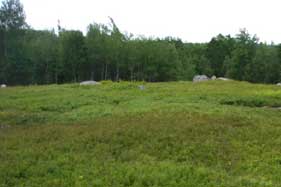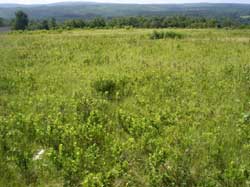304-Organic Wild Blueberry Production
Fact Sheet No. 304, UMaine No. 2029
Prepared by Frank Drummond, Professor of Insect Ecology/Entomology, John Smagula, Professor of Horticulture, Seanna Annis, Associate Professor of Mycology and David Yarborough, Extension Blueberry Specialist and Professor of Horticulture, The University of Maine, Orono, ME 04469. May 2008.
Introduction
Recent research carried out under the auspices of a USDA organic transition grant resulted in a better understanding of the interaction of wild blueberry production tactics such as pruning method, soil pH reduction by sulfur application, and organic fertilizer rates on wild blueberry growth, development and yield. This fact sheet is the product of what we have learned over the past four years during the conduct of this research project.1
The wild, or lowbush, blueberry is one of only four crops native to North America (see Wild Blueberry Fact Sheet No. 220, Wild Blueberry Culture in Maine). There are two species of wild blueberry: low sweet (Vaccinium angustifolium Ait.), which makes up approximately 80- 95% of the cover in the average field, and sour-top or velvet leaf (V. myrtilloides Michx.) The lowbush blueberry can be found from Quebec in the north down to isolated areas of Virginia in the south, west to Michigan and east to Prince Edward Island although the majority of fields are found in Quebec, Maine, and the Canadian Maritimes.
Worldwide production of wild blueberries in 2007 was estimated to be 182 million pounds on roughly 173,700 acres. In the United States, approximately 75 million pounds of berries will be produced on 66,700 acres; Maine alone produces an average of 66 million pounds on 65,000 acres. Of this land, only 854 acres (or 1.4%) are estimated to be organically managed (F. Drummond from 2006 grower survey).
Over 99% of Maine’s entire lowbush blueberry crop is frozen and less than 1% of the crop is sold fresh, but most organically-grown berries are sold fresh. More than 78% of organic growers surveyed in Maine sell their berries through such venues as pick-your-own farms and farmers’ markets. Organically-grown lowbush blueberries in Maine are also used in the production of tea, jams and jellies, dog bones, pies, spreads, yoghurt, juice, and personal care items.
Organic crop production is expected to increase in the future. Many consumers are demanding organic produce at the grocery store and growers are responding to this demand. A 2006 survey of Maine blueberry growers reported that 77% think it is important to use safer insecticides that result in minimal residue on the crop. Forty-nine percent of the surveyed growers in Maine believe that consumers will pay 1% to 10% more for “reduced-risk” blueberries. Consumers are in fact willing to pay much more for “reduced-risk” berries. A September 2007 Maine Organic Farmers and Growers Association price report indicated that organic berries are sold at a wholesale price of $2.50 per pint and at retail at $4.00 per pint, as compared to conventionally produced berries at $0.40 to $1.00 per pound sold to processors. However, there is no universal price premium for organic blueberries. Some organic growers achieve their price premium through value-added processing and packing and others through specific marketing channels, so profitability varies across organic production systems (see Fact Sheets addressing Organic Blueberry Economic Analysis and Grower Case Studies).
Although the tools available to organic growers are somewhat limited, they face many of the same concerns as conventional growers. These include a host of weeds, diseases such as mummy berry blight, blossom blight, red leaf disease, and the insect pests blueberry maggot fly, flea beetle, red-striped fire worm, and blueberry spanworm among others. Much of the development of production tactics relies upon an ecological landscape or habitat management perspective due to the “wild” nature of this crop.
1 Growers use organic methods for a range of reasons, ranging from personal preference for entirely natural methods to a commercially based motivation with formal Organic Certification. This document is not oriented to any particular Organic ‘philosophy’, and the methods discussed within should be considered within the context of a particular farming operation. Note that the inclusion of a practice in this document does not necessarily imply that practice is acceptable for Certified Organic production. Growers should always review their farm plans with their certifying authority before adopting them.
- Managed blueberry field.
- Unmanaged blueberry field.
Blueberry Ecology and a Landscape Perspective
Evolutionary Ecology
Forty thousand years ago, glaciers covered Maine. With the retreat of the glaciers, much of the flora and fauna familiar today colonized the ice-scoured habitat. Therefore, in terms of geological time, wild blueberry is a relatively new plant. As the glaciers retreated, they cleaved and fractured the surface bedrock, leaving the sandy, nutrient-poor soil in which much of wild blueberry is found (though the plant can also be found in silt and loam soils). The ancestral habitat of the lowbush blueberry is significant in that wild blueberry has evolved under low nutrient and drought-stressed environments. Blueberries have adapted to this environment by forming an association or symbiotic relationship with mycorrhizal fungi that aid in the uptake of nutrients, especially phosphorus. Therefore, growers should consider management as a means of providing a competitive edge to blueberry by modifying the environment to favor the growth of blueberry, and at the same time handicap the growth of some of its competitors that we call weeds.
The wild blueberry is also a long-lived plant naturally found in the forest under-story. It has been suggested that some individual clones may reach the age of two centuries or more. Under natural unmanaged conditions, blueberry plants may spend a large proportion of their lifespan within the forest under-story plant community growing vegetatively and hardly ever flowering. This is because low light levels inhibit flower bud formation. This relationship between flower bud formation and light level should be kept in mind when considering the impact of weeds or fields that abut forests, prompting us to ask…why are my blueberries not productive? Blueberry plants are adapted to disturbance events such as burning as a result of evolving in a climate and vegetation landscape where forest fires due to lightning strikes were commonplace. Only 30% of the wild blueberry plant’s biomass is aboveground, allowing the 70% of belowground plant biomass to quickly regenerate the aboveground shoots and leaves. Growers take advantage of this when they prune fields, either by mowing or burning. It has been demonstrated that wild blueberry plants attain higher yields over the course of many production cycles when they are pruned every other year. In the year after the plants are pruned, new vegetative shoots grow from the rhizomes and there is a stimulating effect that produces more shoots from a growing point when pruned. At the end of the year, flower buds form that produce flowers in the subsequent growing season. If plants are not pruned regularly, they will not produce much new growth and will also self-shade. Flower buds will not form on lower branches, and thus the number of berries on the plant will be reduced. This again relates back to floral bud production and light levels. Based upon some of the general ecological relationships of the wild blueberry we believe that organic management of this crop should be firmly grounded in ecology and the associated landscape that blueberry evolved in and occupies today.
A Landscape Perspective for Blueberry Management
Organic blueberry growers face many challenges. They cannot: 1) rotate their crop (although they can rotate the crop cycle, i.e. cropping vs. prune cycle), 2) plant cover crops or green manures, or 3) mechanically cultivate the soil to reduce weeds; and 4) they have a limited number of organically approved pesticides available. Their best chance to sustainably manage wild blueberries organically is to manipulate the crop environment or landscape in a manner that favors fruit production and puts pests (weeds, plant pathogens, and plant-feeding insects) at a disadvantage. In some ways, this can be considered the “Zen” approach to blueberry production, or working within the turbulent forces of nature with awareness. The following tenets suggest means of approaching this strategy.
- Plant relatedness. Blueberries often grow in landscapes as part of the heath community (Family: Ericaceae), which includes other plant species such as huckleberries, cranberries, and rhododendrons. The implications of this are a “two-edged sword” as far as the production of blueberries is concerned. These closely-related plants evolved under the same conditions as the blueberry and may share pests and pathogens, as well as beneficial organisms such as pollinators. For example, both huckleberries and lowbush blueberries are hosts of the fungal pathogen Pestalotia vaccinii and the insect pest the blueberry maggot fly (Rhagoletis mendax Curran). While a blueberry field may be free of other ericaceous plant species, the latter are often found in surrounding forests bogs, fens, and meadows, providing a reservoir for pests and pathogens. Knowing the sources of pests that might colonize a blueberry field is the first step in managing pests. Therefore, it is important to realize that adjacent blueberry fields are not the only source of infestations, but the entire surrounding forested and wetland landscapes are a second source comprised of a patchily distributed heath plant community. An additional aspect of the heath community is the species composition of “blueberry” in a field. The other common Vaccinium species found in blueberry fields is sour top blueberry. The pollen of sour top is incompatible with and causes fruit abortion in the low sweet blueberry. If a particular field has a high percentage of sour top plants (30-50% or greater), a grower will probably not experience a high yield of berries from the low sweet blueberries, no matter how many bees are present during bloom; in fact, a high abundance of bees can reduce productivity. An exception to this might be if all of the sour top plants are confined to one area of the field. Knowledge of this incompatibility allows a grower to assess the productivity potential of a given field and should influence the decision on whether to commit resources to a field.
- Clonal nature of growth. Wild blueberries spread clonally, creating a patchwork mosaic in blueberry fields. Each clone has genetically different attributes, including leaf and flower color, sprout emergence, bloom time, and resistance to pests. In addition, not all clones will be equally productive either because of compatibility with its own pollen or with pollen from neighboring clones or because the plant may not inherently produce abundant flowers. The simple message for this aspect of ecology is that growers should map their fields specific to this clone mosaic and keep records over several years on which clones are the most productive. Therefore, if labor is limiting, rather than spending time and capital trying to improve the yield of all clones, the poor producers included, growers may do better to target the more productive clones for intense management.
- Blueberry fields as islands. The size of a field may affect the crop production and pest levels. In the 1960s the “Theory of Island Biogeography” was developed to explain the relationship between the number and abundance of plant and animal species on islands, and the size of the island. Some of the basic tenets of this theory are: 1) large islands have a higher animal and plant diversity than small islands and 2) more isolated islands (islands further from the mainland or large islands) have less diversity than less isolated islands; therefore 3) small AND isolated islands are more prone to species extinctions and instability (rapid change of plant and animal communities) due to their low diversity. We have found that at least as far as natural enemies, insect pests, and pollinators are concerned blueberry fields are islands…islands in a sea of a forest landscape and that these tenets hold true…on average. So, what can we glean from this? Large fields will tend to have a higher number and diversity of species due to their size. This means that they will, “on average”, have a potential for more frequent pest outbreaks, but at the same time, they will have a larger more stable natural enemy complex to dampen the explosive increase and spread of a pest population during an outbreak. Smaller fields will have fewer and less diverse species present. This means that they are less likely to experience the full suite of wild blueberry insect pests found throughout the state (at least at any one point in time), but also they will have a lower diversity of natural enemies and thus, “on average”, will be more prone to a population explosion should a pest or pathogen find its way into the field. Fields isolated in the middle of forested areas are more likely to be low in the pest diversity; however, a single pest may present serious problems compared to fields adjacent to large production areas, such as the barrens of Washington County. Growers with large fields may face continual lower-level pest and pathogen problems, while growers with smaller fields might expect fewer but larger-scale attacks. Of course, the problem with simple generalizations is that there are always exceptions, especially in light of the specific management that individual fields receive.
Ecological or Landscape Management
- Managing for plant species diversity. There are many ways for growers to manipulate the environment to favor wild blueberries. One way to do this is by promoting and managing flowering plants for beneficial natural enemies and pollinators (see Wild Blueberry Fact Sheet No. 630, Wild Bee Conservation for Wild Blueberry Fields). Flowering plants that provide good pollen and nectar resources for pollinators include willow, maple, wild strawberry, raspberry, lilac, hawthorn, white clover, red clover, meadowsweet, asters, and goldenrod. A more extensive list is included in Wild Blueberry Fact Sheet 630. By carefully enhancing and promoting plant diversity, growers can provide for a wide range of pollinators. Additionally, some insect parasites are associated with certain plants, so by managing these plants, it may be possible to lower insect pest numbers. We have found that plants associated with high levels of parasitoid wasps are: sheep laurel (Kalmia angustifolia), bunchberry (Cornus canadensis), bush honeysuckle (Diervilla lonicera), dogbane (Apocynum androsaemifolium), and withe-rod (Viburnum cassinoides). Of course, this is a balance and one does not want to enhance the abundance of competing weeds in the field interior that are of minimal resource value to natural enemies. Plants of less importance to natural enemies are such as some of the grasses and tree species.
- Managing for non-flowering bee requisites. Growers can also improve pollination by enhancing bee populations through the increase of nesting sites by planting or encouraging woody shrubs with soft pith stems such as elderberry, encouraging standing deadwood, maintaining stonewalls in fields, and managing bare soil habitats for soil nesting bees and by providing them with other necessities such as water, mating sites, and protected overwintering sites. Bees require protection from the high wind and extreme cold, which can be provided by planting or maintaining windbreaks to provide snow cover in the winter. Bees also require a water supply less than a mile (generally the closer the better) from their nest in order to survive; vegetation at the edge of the water allows the bees to land and drink. Bees also need a water source because they incorporate leaves, plant resins and oils, and mud that must be chewed and incorporated with water in their nests. More detailed discussion of these landscape management tactics are discussed in Wild Blueberry Fact Sheet No. 630 and Wild Blueberry Fact Sheet No. 301, Field Conservation Management of Native Leafcutting and Mason Osmia Bees.
- Managing the crop cycle. By managing the cropping cycles of isolated fields, growers may be able to lower the likelihood of pathogens or insect pests attacking the crop. Many fields are divided in half, with one half in a prune year and the other half in a crop year, but insect pests such as the blueberry maggot fly can simply fly to fruit-bearing sections of fields, resulting in a continual population increase each year unless managed with insecticides. An isolated field that is all in the pruning cycle in a given year provides no food source for the blueberry maggot fly and so this pest must emigrate from the field and will be reduced significantly. Pathogens such as the mummy berry-causing fungus can survive because not all of the mummies germinate in a given year. If it is possible to keep all of the fields in an area on one cycle for several years in succession then this may diminish the pathogen inoculum. However, this may not be feasible if you only have one field and need income each year, or if any neighboring fields are not kept on the same cycle.
- Managing blueberry competitiveness. Because wild blueberries are not competitive for nutrients and sunlight with many other plants, the landscape needs to be managed in order to favor their growth and productivity. Weeds such as grasses can be managed by lowering the soil pH to around 4.0 using sulfur, as this favors blueberry growth but not pH sensitive weeds. More details on this are given in the organic weed management section of this paper.
- Managing blueberry in adjacent forest habitats. Blueberries grow and produce fruit in unmanaged forest blow-downs or clear-cut areas adjacent to blueberry fields. Pests and pathogens may colonize and reproduce in these areas. This can be a significant source of invading pest populations. By encouraging reforestation of these areas, growers can reduce sources of disease as well as fruit-infesting pests over time.
The interface between the blueberry field and forest can both provide beneficial resources and challenges for pest management. Flowering plants utilized by natural enemies and pollinators, as well as the insects themselves, have been found in abundance at the edge of the forest and 10m into the forest. However, pests are also found in this borderland habitat. The blueberry leaf beetle (Pyrrhalta vaccinii (Fall)) overwinters in the forest edge and then moves into the field in the spring, stopping once it finds blueberry foliage. Because of this behavior, this pest is most often found along the blueberry field edge, sometimes in such high abundance that it results in defoliation of large contiguous patches of blueberry. This knowledge may not result in a direct habitat management tactic, but it should result in increased vigilance and monitoring of edge habitat by growers. A similar ecology associated with the blueberry maggot fly and invasive weeds is discussed in the insect pest and weed management sections.
- Simulating the natural process of fire. By burning rather than mowing as a pruning method, growers can decrease pest and pathogen sources. The heat of the fire destroys insects and fungal over-wintering structures, leaving fewer organisms to attack the crop in the next year. However, the benefits of this tactic have to be weighed against its cost, both monetary and in terms of lost soil organic matter. More detail of this management tactic is presented in the organic insect pest management and organic weed management sections.
- Within-field management. Field heterogeneity affects crop health and productivity. Areas occupied by tall weeds shade blueberry plants, reducing flower production and subsequently yield. Weeds can also be a source of floral competition, resulting in less bee visitation to blueberry. Field heterogeneity also affects the distribution of pests. Weedy areas, troughs and other low spots in fields tend to be wetter or more humid, which favors pathogens such as the mummy berry-causing fungus as well as the blueberry maggot fly, which causes more damage and lays more eggs in these areas. Identification of pest “attractors” is key to spot treatments or edge treatments with tactics such as burning, hand weeding, or organic pesticides.
Conclusions
Knowledge of blueberry ecology allows the development and practice of landscape management. We are still at a point where this management philosophy is in its infancy, and much progress can be made in developing better management practices by ecologically minded growers. The foundation of this approach is a keen observation in blueberry fields and the surrounding landscape over several years. The coupling of observation with record taking and mapping is a powerful tool for farm management. By creating a map of a field and its adjacent habitat, growers can keep track of weeds, disease, and insect prone areas, as well as high yielding clones. This will also help maximize time and effort by allowing the grower to pinpoint areas that should be managed most intensively. Ecological awareness is crucial to managing the blueberry’s growing environment to decrease disease and pests and increase yield, and this can only be appreciated by walking fields during all seasons of the year. The next two sections of this bulletin discuss pest-specific management tactics.
Organic Insect Pest Management
Philosophy of Pest Management
The insect pest management philosophy for organic growers is similar to that of conventional growers, and that is to first determine what pests are in the field, determine pest abundance, and if the pest population is economically threatening in order to customize a management response. The MOST important prerequisite to pest management is knowledge of pest biology and ecology. As previously mentioned, the first line of defense is managing the field landscape in order to shift the balance in favor of the blueberry plant. The second line of defense is reducing a pest’s density after it has been discovered in the field. This decision is entirely based upon the grower’s philosophy on the costs and benefits of risk. We have formulated pest threshold levels for most pests (see Wild Blueberry Fact sheet No. 204, Integrated Crop Management Field Scouting Guide for Lowbush Blueberries and Wild Blueberry Fact Sheet No. 201, Monitoring for the Blueberry Maggot). These thresholds represent pest levels that result in significant damage that warrants control, at least in terms of the traditional cost of control or the grower perception of risk. The thresholds can be viewed as lower limits for many growers, or at least a baseline so that others can gauge their aversion to risk and decide whether to accept greater damage before resorting to control through cultural methods such as burning or applying an organically approved insecticide. Insecticides, despite being organically approved, should always be considered the tactic of LAST resort for most organic growers.
A management plan can only be formulated if you know what pest you have in the field. The wild blueberry pocket identification guide and the detailed pest-specific Wild Blueberry Fact Sheets are important resources for making correct identifications and can be found on the Fact Sheets page of the Maine Wild Blueberries website. A variety of methods are available to help growers discover what pests are in their fields, where they are when they are there and how many of them are there. These methods are discussed in Wild Blueberry Fact Sheet No. 204, Integrated Crop Management Field Scouting Guide for Lowbush Blueberries. In order not to duplicate this information, only a list of sampling techniques will be discussed here. A sweep net can be used to effectively detect all wild blueberry pest insects except for blueberry maggot fly, red-striped fire worm, thrips, and tip midge. Knowledge of insect activity is important in using the sweep net effectively. It may not matter what time of day one sweeps a field if the purpose is to detect and identify the insect pest. However, if an estimate of pest abundance is desired then the behavior of the insect must be taken into account. Blueberry spanworm and strawberry rootworm are both referred to as crepuscular insects. This means that they are most active and up on the foliage when light levels are low in the early morning and late evening. Therefore sweeping at these times will allow you to more accurately assess the population. Sticky traps (Phercon® Baited AMF sticky traps (OMRI approved)) are used for monitoring blueberry maggot flies. Plant-based glues are available for application on blueberry maggot fly sticky traps but are only about half as effective as those coated with conventional glues, so growers should double the number of flies caught with plant-based glue traps in order to equate the trap capture with recommended threshold levels. Non-baited yellow or blue sticky traps can also be used to monitor the emergence of blueberry thrips. These traps are placed in the early spring in infested patches mapped in the field during the previous growing season. The secret to using these traps effectively is placing them on stakes a few inches from the soil surface, as thrips are poor fliers. Visual observation is also important, as pests such as thrips and gall midge produce symptoms on the plants. Transects through the field should be walked frequently in an X or Z pattern to assess defoliated areas or damage symptoms due to thrips, tip midge or red-striped fireworm. The universal truth is that growers who are knowledgeable, observant and monitoring their fields will be able to detect and respond to insect outbreaks before they cause economic losses.
- Designing a sustainable cropping system. By carefully designing and planning ways to best manage fields, growers can minimize the effects of pests. Burning is expensive, but the occasional hard burn for pruning will knock back pest populations that are on the rise. If a field is surrounded by woods, cropping the entire field on one cycle can curtail blueberry maggot fly populations. Conserving and enhancing natural enemies by improving plant species diversity, providing non-plant requisites, and minimizing the use of pesticides will also help control pest populations.
- Understanding natural enemies. Natural enemies of wild blueberry pest insects include both specialists that feed on only one species of pest insect, such as many parasitic wasps, and generalists such as spiders, which feed on many species of insects. Natural enemies are often predatory insects but are also arachnids such as spiders, harvestmen, or mites, and pathogens which are microorganisms that cause disease. Two species of parasitic wasps (Opius ferrugineus Gahan and O. melleus Gahan) lay their eggs in the blueberry maggot. The immature wasps then hatch and kill the maggot after it burrows into the soil. Ants, ground beetles, harvestmen, and spiders are all generalist predators and they prey upon common blueberry insect pests such as blueberry spanworm, blueberry flea beetle, and adult blueberry maggot flies. Allegheny mound ants eat red-striped fire worms and blueberry flea beetles, (see Wild Blueberry Fact Sheet No. 195, Beneficial Insect Series 1: The Allegheny Mound Ant). The ground beetles Harpalus rufipes and Calosoma calidum are present in the field at times when insect pest species are at vulnerable stages, such as the egg, larval, and pupal stages that either have no or limited movement for escaping predation. H. rufipes is found during May and again in August and September, which coincides with both the egg stages of blueberry spanworm and blueberry flea beetle and the larval life stage of red-striped fire worm. C. calidum is found during June and July, which is the time when blueberry spanworm and blueberry flea beetle are in their larval stages. H. rufipes is also beneficial in that it eats weed seeds. Harvestmen, a group that includes daddy longlegs, are omnivorous and primarily eat small insects such as thrips, insect eggs such as blueberry flea beetle and spanworm eggs, and fungi. Most harvestmen ambush their prey, though some may actively hunt. The dominant predaceous spiders in blueberry fields are wolf spiders, which are generalist nocturnal hunters. Useful pathogens include fungi, bacteria, and viruses. The fungus Beauveria bassiana is naturally occurring in Maine soils and kills many species of insects including blueberry maggot flies, blueberry spanworm, blueberry thrips, and grasshoppers. A commercial formulation of this fungus is used for organic control of blueberry flea beetle. A toxin produced by the bacterium Bacillus thuringiensis kurstaki (known as Bt) is recommended for control of blueberry spanworm, and two undetermined naturally occurring viruses have also been found to kill blueberry spanworm and end outbreaks when the pest is at high density.
Natural enemies work by suppressing the frequency of outbreaks and dampening their severity, but they do not prevent pest problems from occurring. The graph in Figure 1 shows the results of sweep samples in a hypothetical field. When natural enemies are present, pest outbreaks occur less frequently and in lower numbers. When natural enemies are absent or in minimal numbers, pest outbreaks are more severe and more frequent. It is also important to remember that specialists are dependent upon particular pests for food and when the number of available insect pests is low, the natural enemy numbers will also drop precipitously until another pest population boom occurs. Figure 2 shows the fluctuations in blueberry maggot populations in Washington County from 1998 to 2006. Generalist predators can feed upon a wider range of pest species, but may also eat each other. We often see Allegheny mound ants eating the ground beetle H. rufipes. - Enhancing natural enemies. There are a number of ways for a grower to enhance the diversity and numbers of natural enemies. Insecticides, even organic ones, can be lethal to natural enemies so their use should be minimized. When insecticides are necessary, growers should choose those that are the least damaging to natural enemies. The annual insect control guide (see Wild Blueberry Fact Sheet No. 209, Insect Control Guide for Wild Blueberries) gives toxicity ratings for various insecticides. The edges of fields are rich natural enemy habitats, so care should be taken to protect these areas by avoiding insecticide application there. We have found that natural enemies are distributed differently in fields. Spiders tend to be more abundant along field edges, while harvestmen (daddy longlegs) are associated more with field interiors. Mapping out a field’s pest infestation will allow spot treatments to be made in areas with high pest densities and avoid other areas of the field that can serve as natural enemy reservoirs.
Growers should make requisites available for natural enemies, including maintenance of flowering plants that harbor both hymenopterous parasites and alternative prey for generalist predators. This provides direct food sources as well as hosts for insect herbivores which provide food for natural enemies when pest numbers are low. Disturbance, which includes burning, mowing, rock removal and land leveling, should be minimized as much as possible since it disrupts natural enemy habitat. For example, mowing machines have been known to shave off the tops of Allegheny mound ant hills. Our research in organic fields has demonstrated that burning tends to reduce population levels of ants and spiders, but not harvestmen. This is probably due to the fact that harvestmen tend to re-colonize fields from the forest edges each year and eventually build up in the field interiors. We have demonstrated that spiders and ants are positively correlated with higher yields in organic fields. This is most likely due to their predation upon blueberry insect pests. Between 2004 and 2007 we showed that as ant and spider numbers increased, many of the pest insect population levels decreased, thereby causing a reduction in leaf and fruit damage. This is the first documentation of the predatory influence of natural enemies on blueberry pest insects at a population level.
Insect Pests of Concern and their Management
Most pests of wild blueberry are infrequent, but vigilance is vital to ensuring that outbreaks remain infrequent and pest populations stay low. Table 1 lists the insect pests of concern, management strategies that work and ones that do not. A fact sheet for each pest species is available on the Wild Blueberry website, which provides additional information on their biology. Over-wintering insects are often found in the litter layer within fields, so hard burns (ignition of the litter with fossil fuels or large amounts of straw) may be recommended to kill them. For organic pesticide application rates, see the current insect control guide, Wild Blueberry Fact Sheet No. 209. For more information see Cultural Management for Insects and Diseases in Wild Blueberries, Wild Blueberry Fact Sheet No. 253, Integrated Crop Management Field Scouting Guide for Lowbush Blueberries, Wild Blueberry Fact Sheet No. 204 and the accompanying Blueberry ICM Pest Management worksheets.
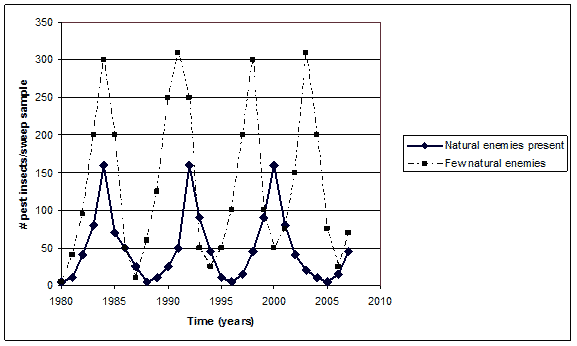
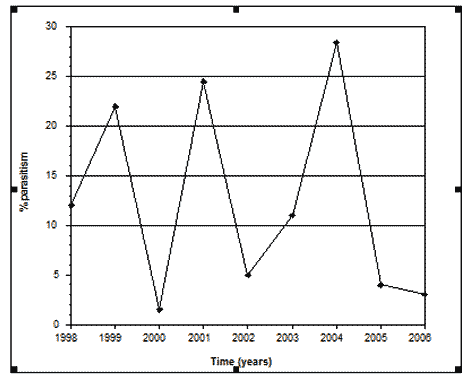
| Table 1. Insect pests of concern and their management. This table lists several control tactics for the common blueberry insect pests, but there are other considerations that need to be taken into account when employing them (* has not been tested, but hypothesized to be effective in managing a given pest). | ||
| Insect & Wild Blueberry Factsheet # | Management options | Ineffective ways to manage |
| Blueberry maggot fly (See fact sheet No. 201) |
1. Organic insecticide: Naturalite®
2. Drift fence |
1. Delaying harvest until the end of summer 2. Organic insecticide: Surround: poor coverage on lower leaves, hard to get onto and off berries 3. Neem and Pyrethrum: natural plant-based insecticides 4. Trapping out flies with lots of traps 5. Burning: pupae are deep underground (one to two inches) not affected by burning 6. Bait spray of molasses: does not attract flies into the sprayed section of the field 7. Insecticide-treated sphere traps: not effective enough of an attractant in a field of ripe berries |
| Strawberry rootworm (See fact sheet No. 199) |
1. Organic insecticide: Entrust® 2. Field wet area management, e.g. using drainage tiles * 3. Larval host plant management (brambles, raspberries, strawberries) * |
1. Burning: strawberry rootworm over-winters in the forest |
| Blueberry spanworm (See fact sheet No. 197) |
1. Hard burn during pruning 2. Biological control: Bacillus thuringiensis 3. Organic insecticide: Entrust® 4. Mow when virus and wasp parasites occur in abundance* |
1. Use of insecticides against adult moths 2. Nematodes not effective |
| Blueberry flea beetle (See fact sheet No. 200) |
1. Hard burn during pruning 2. Organic insecticide: Entrust® 3. Biological control: Beauveria bassiana |
1. Pepper wax spray not effective 2. Nematodes not effective |
| Blueberry leaf beetle (See fact sheet No. 203) |
1. Organic insecticide: Entrust® 2. Biological control: Beauveria bassiana |
1. Burning: blueberry leaf beetle over-winters in the forest |
| Blueberry thrips (See fact sheet No. 202) |
1. Delay pruning: let thrips colonize plants, form galls, then prune in mid-June by mowing or burning | 1. Organic insecticide: Entrust®, not persistent on foliage 2. Biological control: Beauveria bassiana, does not come in contact with thrips to infect |
| Red-striped fireworm (See fact sheet No. 205) |
1. Hard burn | 1. Biological control: Bacillus thuringiensis (Bt) is not effective against these caterpillars since they are protected by leaf roll, a similar reason of why Entrust is not an effective control. |
| Blueberry sawfly (See fact sheet No. 206) |
1. Hard burn | 1. Biological control: Bacillus thuringiensis (Bt) is not effective against these caterpillars since they are not moth larvae |
| Blueberry gall midge | 1. Hard burn | |
| Grasshoppers (See fact sheet No. 198) |
1. Biological control: Beauveria bassiana 2. Manage grasses, their preferred food |
1. Biological control: Nosema (protozoan) is not effective |
- Burning. As previously mentioned, burning as a method of insect control needs to ignite the litter. In addition, more effective burning may result in the fall compared to the spring. This is due to two reasons. First, the litter is often drier in the fall than in the spring. Second, weathering and frost heaving of the soil tends to work small eggs and pupae down deep into the litter moving them out of the zone that is most likely to be burned. Our research from 2004-2007 suggests a light burn may result in a situation where natural enemy populations are detrimentally affected while insect pests that survive the light burn increase to greater numbers than if the field was not burned.
- Delayed pruning. Control of thrips through a delayed prune works on the principle that during spring, thrips are either in the soil, emerging from the soil and colonizing leaves, or inside leaf curls. This tactic is one in which most of the thrips are allowed to emerge from the soil in the spring, colonize the leaves, and then are mowed or burned. The strategy has to be anticipated the preceding year during which a thrips infestation is marked out with stakes and then visited the following spring. When the leaves are curled and it is approximately mid-June, the patch can be pruned. A mid-June prune will still allow the blueberry plant to develop flower buds by the end of the summer with minimal reduction in potential yield the following year.
- Use of Bt. Bt is a collection of toxins from ubiquitous soil bacteria. These toxins are only effective against moth and butterfly caterpillars. It is much more effective against young spanworm caterpillars (90% to 100% mortality), than against late stage caterpillars (40% to 50% mortality), and so decisions to use this biological control should be based upon the size of the caterpillars.
- Use of Beauveria bassiana. Beauveria bassiana spores are very susceptible to mortality when exposed to UV radiation. Because of this, this fungus will be more effective when applied in the evening compared to the early morning. Also, B. bassiana is more effective against the soft-cuticle flea beetle larvae than the hardened adults. We also evaluated this fungus against thrips, red-striped fireworm, grasshoppers, and blueberry spanworm and none of these pests are controlled well with B. bassiana.
- Use of spinosyns. The active ingredient in the spinosad chemical group, spinosyn, is rapidly broken down by sunlight and so applications are best made in the evening, although one should not expect efficacy for much more than two days at the most for the product Entrust®. The exception to this may be Naturalyte®, which contains spinosyn in a sugar food bait. The target species for Naturalyte® is the blueberry maggot fly, which appears to be most active from late morning to late afternoon. Activity will be related to feeding and intake of the food bait.
- Use of other insecticides. Over the past decade, other organically approved insecticides have been evaluated for their efficacy against blueberry insect pests.
Neem (azadirachtin): the oils extracted from the neem tree have been evaluated against the blueberry maggot, red-striped fireworm, blueberry flea beetle, blueberry leaf beetle, and blueberry spanworm. It has been found to be inconsistent and so is not a recommended control tactic for these pests.
Trichogramma spp. egg parasitoids: parasitic wasps were evaluated as potential biocontrol agents for the blueberry spanworm, but were not economical on a field basis.
Steinernema spp. nematodes: parasitic soil dwelling nematodes were evaluated for control of thrips and flea beetle, but were not effective biocontrol agents. They have not been tested against strawberry rootworm larvae and this should be a future objective in organic management.
Pyrethrum: a natural plant compound extracted from Chrysanthymum spp. was evaluated against blueberry maggot fly but was not found to be effective. Generally, pyrethrum results in a quick knockdown of the insects, but often they recover.
Fish waste fertilizer: particular fish oils have shown to be insecticidal, probably by dissolving the waxy layer that protects most insects from desiccation. Applications against flea beetle did not suggest any such activity.
Kaolin: a clay-based product that has been used successfully to deter homoptera and fruit flies. Trials designed to evaluate control of blueberry maggot fly did not result in any promising conclusions. High levels of kaolin coverage over the fruit are needed to achieve any sort of control and we did not find this to be possible in the field.
Cayenne pepper: this plant product has been shown to be a suitable insect repellent. Trials against flea beetle did not result in any evidence suggesting that it could be effectively used. Blueberry maggot fly might be a possible target, but one that has not yet been experimentally considered.
Limonene: This natural citrus product mostly acts as an antifeedant towards insects. After having fed on leaves coated with this non-toxic plant compound they stop feeding. It was not an effective control against thrips, strawberry rootworm, flea beetle, and blueberry spanworm.
Others not very successful: We have investigated many other potential control agents with little success. 1) Virus was evaluated as a biocontrol against blueberry spanworm, 2) insecticidal soaps against flea beetle, blueberry sawfly and spanworm, 3) molasses bait against blueberry maggot fly as an attract and kill technology, 4) Nosema microsporidian parasites as a biological control against grasshoppers, and 5) Bt San Diego against blueberry flea beetle.
Alternative organically approved insect pest management techniques have been well researched in the Maine blueberry ecosystem, but new techniques are emerging. Growers should not hesitate to conduct their own experiments.
- Parasitoids and naturally occurring disease. In both blueberry maggot fly and blueberry spanworm, the incidence of natural parasitism by wasps and/or disease can lead to a temporary collapse of the population, which therefore may not need control the following year. In the case of the blueberry maggot fly, the wasps are cryptic because they spend most of their lives inside the fly larva and pupa. To determine if parasitism is high (30% or more), collect 100 pupae by raking maggot infested berries and setting them up over a tray of sand. In the fall, float out the pupae that have burrowed into the sand and store pupae in damp vermiculite in cold storage until June. Take the pupae out and emerge the flies from the pupae. Hold the pupae for another month and wasp adults will emerge if pupae are parasitized. Estimate the percent parasitism as a ratio of wasps per 100 pupae. This monitoring method is not too time-consuming and should give one an indication if fly numbers might be high or low that summer.
Blueberry spanworm is parasitized by both wasps and viruses. These are present during the spring when the large caterpillars are present. The wasps will be caught in a sweep net with the larvae and the virus infected caterpillars will exhibit “viral syndrome” via their flaccid, a deflated water-balloon-like appearance. If the percentage of wasps and virus diseased caterpillars is high, i.e. more than 50%, then burning in the subsequent fall or spring to control the population the following year could destroy all of the natural control agents and actually result in a resurgence of the population over the next several years instead of the predicted population crash, which usually lasts for several years. - Strawberry rootworm. It has often been observed that strawberry rootworm infestations tend to be in wetter sections of fields. This may be due to these wet areas being more optimal for larval host plants such as brambles, raspberries, wild strawberries, etc., or better for larval survival. A perennial strawberry rootworm problem might be worth the experimentation of reducing soil moisture in the infested vicinity. This can be accomplished by tiling or ditching. In addition, the removal of larval host plants, where possible, is another environmental manipulation that may have an impact, depending upon the abundance of larval host plants across the local landscape.
- Blueberry maggot fly. The blueberry maggot fly is the most challenging blueberry insect pest to manage. This is mainly because the insect is cryptic and difficult to detect until too late. The majority of the blueberry fly population colonizes crop fields each year from adjacent areas that had berries the previous year. The colonization is characterized by a short hopping flight that takes them into the field slowly and results in the majority of the flies being associated with field edges. Populations fall off precipitously towards the interior of the field. Because of this, monitoring should be concentrated along field edges. In addition, traps should be deployed adjacent to maggot production areas the previous year, i.e. in fields in the alternate cropping cycle, in forest edges that receive sunlight that have blueberry under-story, and in blow-down areas in the forest border habitat characterized by flowering and fruiting blueberry plants. Within the edge areas, traps should also be deployed in weedy areas, in low lying troughs or depressions, and in highly productive clones. Traps should be placed just above the blueberry plant canopy, not a foot or two above the canopy. Placement of a grid of traps throughout the field will allow one to spot treat for the blueberry maggot flies since in most cases we find the populations to be highly aggregated and not spread uniformly throughout the field. Perimeter treatments are a larger scale version of the spot treatment tactic (see Wild Blueberry Fact Sheet No. 201, Monitoring for the Blueberry Maggot Fly). In Canada it is recommended that the flies be controlled in the pruned fields during fly emergence; this is a strategy worth testing.
- Drift fences are suitable for very small fields. They take advantage of the flies’ behavior of flying just over the crop canopy. We have reduced populations of flies by intercepting them along the edges of fields with four-foot high window screening erected along the field perimeter being invaded by the flies.
As mentioned previously, the best management tactic for blueberry maggot fly is isolated fields. If an entire isolated field is kept on a single cropping cycle and not split into two alternate production units, the flies’ life cycle will be disrupted and populations will be greatly reduced.
Organic Disease Management
Field Selection
Fields with low levels of disease, such as mummy berry blight, should be chosen for conversion to organic production. Evaluating fields in their crop year for mummy berry blight during the early summer and later in the season for leaf spot, powdery mildew, and leaf rust diseases will help determine the best fields for transitioning to organic management. Mummy berry blight can have devastating effects on wild blueberry plants if the weather conditions in the spring are suitable for infection and there is a large amount of inoculum present in the field. There can be a significant decrease in berry size on wild blueberry plants with greater than 30% incidence of mummy berry blight. Fields with initially low levels of inoculum can be maintained with low levels of disease for many crop cycles. The results from a trial field transitioning to organic production demonstrate that low levels of mummy berry inoculum can be maintained. In 2005, there were very favorable weather conditions, cool temperatures with lots of rain events, for mummy berry blight infection, and this resulted in a high incidence of this disease throughout the state. In the transitioning field in 2005, only 5% of the stems had mummy berry blight, and for the second crop cycle in 2007, the trial field had less than 1% stems with mummy berry blight with spring weather conditions that were about average for mummy berry blight infection. The level of disease in this field was very low in 2005, indicating that the level of initial inoculum was very low and that the level of inoculum did not increase even with highly favorable weather conditions.
Effects of Field Management on Disease
Management techniques that provide vigorous growth of the blueberries with no nutrient stress and low weed cover will usually also provide plants with conditions that allow for low levels of disease. There are management techniques that can help control disease in wild blueberry fields. Previous research done in 1990 by Dave Lambert at the University of Maine found pruning by burning decreases the level of mummy berry blight incidence compared to fields that are pruned by flail mowing. This is because pruning by burning destroys most of the mummy berries that over-winter on the surface of the soil under the leaf litter. In the field transitioning to organic production, there was no significant effect of the type of pruning, either flail mowing or burning, on mummy berry blight incidence in the first two crop cycles. Figure 3 shows results for the first crop cycle. This field had low levels of disease initially, but flail mowing over multiple crop cycles could allow a buildup of mummy berries in the leaf litter. Pruning by burning may also decrease some leaf spot diseases but does not have an effect on powdery mildew or red leaf diseases.
Sulfur treatment to lower the soil ph of a field, has no direct significant effect on mummy berry blight incidence but may have a long term effect if sulfur application helps to control weed growth. In the transitioning field, there was a significantly higher incidence of mummy berry blight in plots treated with the highest level of fertilizer treatment (45 kg N/acre) than the control (0 kg N/acre) or low fertilizer treatment (22 kg N/acre) (Figure 4). The high levels of fertilizer may make the plants more susceptible by producing new tissue during the infection period. However high rates of fertilizer also produce more weeds that blueberries would be competing with for nutrients. Higher weed cover, particularly grasses, can grow between and over blueberry plants increasing the relative humidity around the blueberry plants which improves conditions for infection by a variety of pathogens.
Organic Methods to Control Mummy Berry Blight
Currently, pruning by burning and mulching are the only recommended organic methods of controlling mummy berry blight. Pruning by burning was described above. Mulching prevents the mummy berries from being able to shoot their spores into the air and therefore prevents them from getting to the plants. Mulching also improves water retention around the plants and can provide a thicker organic layer. In experiments in two wild blueberry fields, one organic and one conventionally managed, peat mulch was spread to approximately 1 to 1.5 inches thick in the third week of April, which was before bud break in the second field but after initial bud break when the plants were already susceptible in the first field. The two fields used for this experiment were approximately 30 miles away at similar latitudes but they were a week apart in their leaf bud development. Mulching in the second field significantly decreased the incidence of mummy berry blight compared to the control treatments without mulch (Figure 5B). The first field was mulched too late, so some infection had already occurred before the mulch was put down (Figure 5A). In both fields, mulched plants had an improved appearance, with denser, greener plants, relative to the control areas with no mulch. In fields with low levels of mummy berry disease, mulching wet areas or areas previously known to have mummy berry disease may provide the necessary level of control. One research project by growers might be to assess the effectiveness of mulching in the fall or winter.
Average Percentage of Stems Infected with Mummy Berry Blight 2005
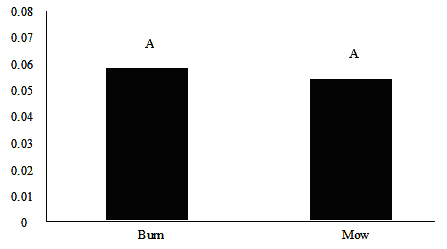
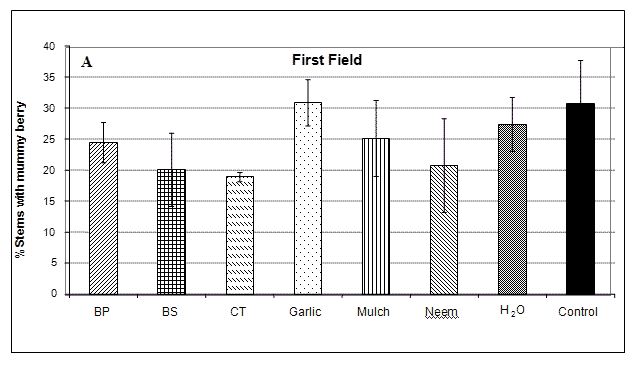

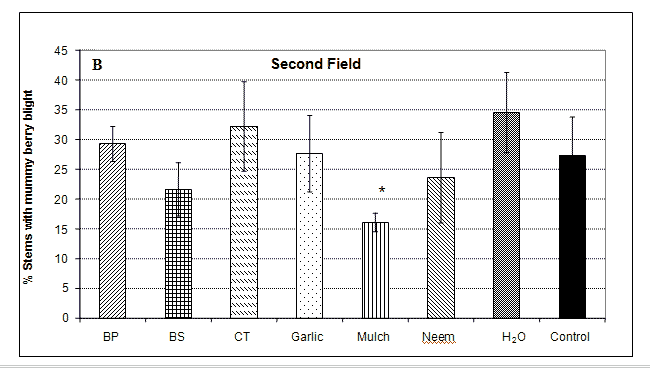
Figure 5A and B. Effect of organic controls on mummy berry blight in two fields in 2006. BP=Bacillus pumilus, BS=Bacillus subtilis, CT=compost tea, Garlic=garlic adjuvant, Mulch=3 cm peat moss, Neem=Neem Oil, H2O=water, Control=no treatment. * Asterisk indicates significant difference from control at a >90% confidence level. Bars indicate standard error from the mean.
Other organic fungicides were also tested by applying them every three to four days during the period of leaf development, from mid April to mid May, when blueberry buds are susceptible to infection by Monilinia. None of the other treatments, including Serenade (Bacillus subtilis, AgraQuest), Sonata (Bacillus pumilis, AgraQuest), aerated compost tea made with Coast of Maine Lobster Compost, Biolink (a garlic and yucca adjuvant, Westbridge) or Trilogy (neem oil, CertisUSA) decreased mummy berry blight and none of these materials can be recommended for control of mummy berry blight.
Pollination and Organic Production
Much information is currently available for blueberry growers wanting to manage pollinators and enhance pollination on their farms (Table 2). For the most part, this information is pest management neutral and applies equally to the organic grower as well as to the non-organic grower. The following is a list of wild blueberry fact sheets that address various aspects of pollinators and pollination.
| Table 2. List of pollination and bee fact sheets pertaining to wild blueberry. | |
| Topic | Wild Blueberry Factsheet* |
| Pollination of the lowbush blueberry | 629 |
| Use of honey bees and evaluating hives | 629 |
| List of commercial honey bee colonies | 224 |
| Use of commercial bumble bees | 302 |
| Use of alfalfa leafcutting bees | 300 |
| Management of native leafcutting bees | 301 |
| Conservation of wild native bees | 630 |
| Effects of organic insecticides on bees | 209 |
| *See the Maine Wild Blueberries website, Fact Sheets page | |
However, there are certain aspects of pollination and pollinator management that may be pertinent to organic wild blueberry production but are not covered in the current Wild Blueberry Extension Fact Sheets, including floral competition and organic honey bee colonies. See also the link to the publication Farming for Bees: Guidelines for Providing Native Bee Habitat on Farms in the Fact Sheet page of the Wild Blueberry website.
Floral Competition
It is generally acknowledged that alternative sources of pollen and nectar are extremely beneficial for maintaining and enhancing native bee populations; see Wild Bee Conservation for Wild Blueberry Fields, Wild Blueberry Fact Sheet No. 630, for more information. This is because many native bees have life cycles such that the adult bees need to collect nectar and pollen to feed their young during blueberry bloom, but also at times before or after bloom, depending upon the species of bee. However, high abundance of flowering plants that are rich in nectar and/or pollen that flower at the SAME time as wild blueberry can be detrimental to pollination in two major ways. First, attractive plants such as sheep laurel or lambkill (Kalmia angustifolia) can draw away honey bees, commercial bumble bees and native bees from wild blueberry so that visitation of the blueberry flower is reduced, especially when blueberry is in close proximity to these alternative flowering plants. A second detrimental effect is that bees may visit an alternative flowering plant first and become dusted with pollen and then visit a wild blueberry and thus place this foreign pollen on the blueberry stigma. We have documented this when blueberry is in close proximity to Japanese barberry (Berberis thunbergii). The end result is that fruit set in blueberry is reduced because the foreign pollen occupies space that blueberry pollen would germinate on. We do not have specific guidelines on which plants are most harmful and at what densities, but we do recognize that alternative co-flowering plants can significantly reduce blueberry pollination. It is probably true that the higher the abundance of alternative nectar and pollen sources during bloom, the lower the potential blueberry fruit set. A grower can get a feel for this effect by observing patches of co-flowering alternative floral resources and blueberry simultaneously and record the number of bees visiting each floral species.
Organic Honey Bee Colonies
Those organic growers wishing to rent honey bees or manage honey bees themselves should be aware that honey bees have a multitude of pests. In order to keep honey bee colonies healthy and populous, these pests need to be managed, and some of the more commonly used management tactics are pesticides and antibiotics applied in the hive. Therefore, if one is considering renting honey bee colonies, the bee keeper should be contacted and questioned as to whether cultural methods are used for management of the bacterial disease American foulbrood by selection of tolerant or resistant crosses of bees, or by colony destruction and burning infected hives in lieu of antibiotics. The fungal disease chalkbrood is managed by minimizing working bees in cold weather that can chill the brood, selecting tolerant races of honeybees and through colony destruction in lieu of fungicides. Mite management is based upon use of screened bottom boards, drone traps, confectionary sugar and lard, essential plant oils or using resistant bee crosses in lieu of using hive based insecticides.
Organic management of hives by the grower requires organically approved management tactics as described above but starts first with acquiring colonies that are disease and pest-free (or nearly so). Organic management of honey bees is not the focus of this bulletin, but this information can be found by contacting our Maine State Apiculture specialist, Mr. Tony Jadczak, in the Maine Department of Agriculture, or by reading pertinent articles that have been published in the American Bee Journal.
Organic Fertility Management
Conventional fertility management of wild blueberry fields has been based on soil sampling to determine proper soil pH, and leaf tissue sampling to evaluate nutrient deficiencies. Sampling methods have been provided in Wild Blueberry Nutrition Series: Leaf and Soil Sampling Procedures Wild Blueberry Fact Sheet No. 222. Wild Blueberry Fact Sheet No. 223, Lowbush Blueberry Nutrition Series: N-P-K contains information about the nutrient needs of plants and the nutrient standards used for assessing plant health for wild blueberries. These values are valid for organic production.
Factors Affecting Wild Blueberry Nutrient Uptake
There are a number of factors that affect the uptake of nutrients needed for good growth and productivity, including the presence of weeds, soil pH, water availability and the presence of soil nutrients.
Weeds compete with blueberry plants for soil nutrients. Leaf tissue samples from weedy fields are often low in nitrogen (N), but this deficiency, less than 1.6% N on a dry wt basis, increases to a level above the standard when weeds are controlled. Controlling weed competition increases the availability of soil nutrients for the blueberry plants. Existing weed populations will determine if fertilizer can be used. Native populations of wild blueberry are often found at the tops of mountains or on outcroppings, rather harsh conditions with thin or nutrient-poor soils. Under these conditions, they manage to exhibit a competitive advantage over most weeds. On heavier soils, weeds tend to be more competitive than wild blueberries, but on poor soils, the wild blueberry only produces a marginal crop of berries. One way of enhancing productivity is to correct nutrient deficiencies to allow for the more balanced nutrient uptake and vigorous growth that are associated with larger numbers of flowers and fruit. There is, however, a delicate balance between feeding blueberries and feeding weeds. What can be done to shift the balance to wild blueberry, giving it a competitive edge? As discussed previously, wild blueberries have evolved and adapted to survive in acid soil, at a soil pH less than 5.0, in which heavy metals like aluminum, copper, and manganese are more soluble. Most weeds are less tolerant of these acid soil conditions.
Shifting the Balance of Competition in Favor of Wild Blueberry
Lowering soil pH to as low as 4.0 can favor wild blueberry competition with weeds. In other pH studies, wild blueberry yield was not adversely affected when soil pH was lowered to 3.9, and weed populations were visibly affected by lowering the soil pH. The 2004 application of sulfur in the Organic Transition Study resulted in a lower soil pH, compared to not using sulfur, during each year of the study (Figure 6). By 2006, soil sulfur (S), manganese (Mn), copper (Cu), iron (Fe) and magnesium (Mg) concentrations were higher in plots that were treated in 2004 with 1000 lbs/acre sulfur compared to the untreated plots. Soil samples taken in 2007 had similar high concentrations of heavy metals.
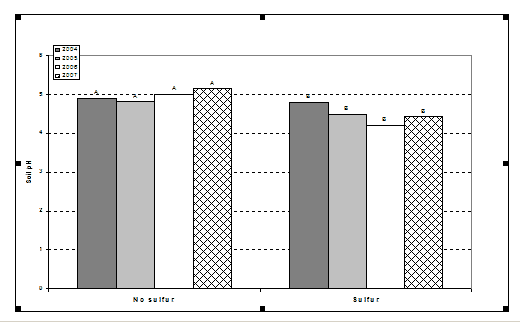
Some nutrients like calcium (Ca) and boron (B) are dependent on adequate soil moisture for movement into the plant. These nutrients may be present in blueberry soil but in dry years show up as deficiencies due to lack of movement into the plant. Supplemental irrigation would assure their sufficiency. Soil nutrient concentrations are dependent on the origin of the blueberry soil since nutrients vary in different soil components. The surface organic layer holds and releases nutrients as organic matter slowly breaks down. Presence of an adequate organic layer or “pad” prevents added nutrients from being leached out of the root zone. Surface mulch can replenish an inadequate organic pad and help to hold applied nutrients, reduce soil moisture evaporation and encourage rhizome spread by lowering soil temperature. Wild Blueberry Fact Sheet No. 228, Mulching to Improve Plant Cover, provides more information about mulching. Pruning by fire can reduce the thickness of the organic pad when “hard burns” are employed. Only enough heat to kill the stems is necessary for a proper prune. Pruning by mowing avoids the destruction of the organic pad and will improve the surface organic layer over time, but does not provide the sanitation that comes with burning to help control weeds and insect pests. In our four-year study, we saw no effect of pruning method on soil or leaf nutrient concentrations but did find that berry yield was higher in burned plots in both 2005 and in 2007, which suggests that the major effect that pruning method has on yield is through controlling the weed.
Fertility and the Importance of Weeds
Weeds were increased by the fertilizer application in our study. Leaf nutrient concentrations in control plots in 2004 were above the standard for N at 1.6% but below the standard for P at 0.130%. In 2004, applications of 20 or 40 lbs N/acre from the organic fertilizer Pro-Holly2 (4-6-4) had little effect on leaf concentrations of N, P, or K, and there was no effect on the 2005 yield. Weeds present in 2004, such as broadleaf weeds and grasses, were significantly increased by fertilizer applications (Figures 7 and 8). When treatments were reapplied in 2006, leaf N was raised from below to above the 1.6% N standard by the 40 lbs N/acre rate. Leaf P was also deficient and was increased by the higher rater of organic fertilizer, but not to a level above the standard. Weeds such as grasses were again stimulated by the 2006 fertilizer treatments (Figure 9). The 2005 and 2007 yields were not affected by fertilizer applications, but in 2007 showed a trend of increasing yield when lowering pH with sulfur and pruning by fire (Figure 10). Correcting P deficiency should result in even greater yields since in conventional fields we have seen a yield response by increasing the P leaf level above the deficiency. The research trial is going to be continued on for an additional two years to see if this can be accomplished.
2 NOTE: By organic regulations, only 20% of the Nitrogen need can come from Chilean nitrate. That means if we use the average rate of fertilizer used on commercial fields then only 7.2 pounds of nitrogen per acre can come from Chilean nitrate.
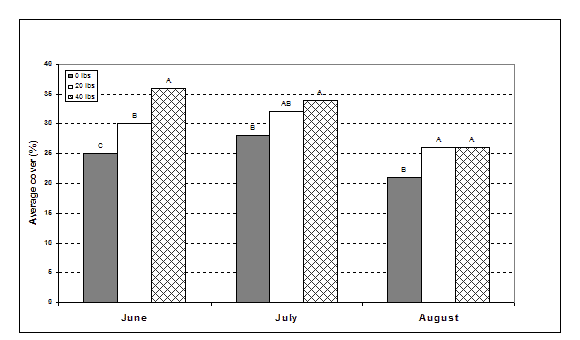
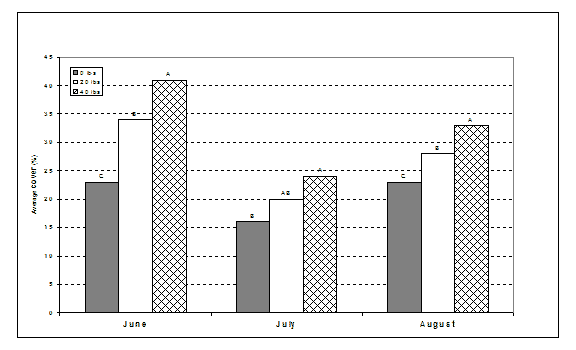


Organic Weed Management
Cultural Management for Weeds in Wild Blueberry, Wild Blueberry Fact Sheet No. 252, provides a good foundation of cultural weed management practices but the organic transitions research project enabled us to confirm and expand our knowledge of these practices (Table 2).
Field Selection
USDA organic certification rules require that there is a documentation of three years of no non-organically certified pesticide, fertilizer or herbicide use on the field. It is important to implement the cultural management practices as soon as the decision is made to manage the field organically. It is much more effective to limit the growth of weeds early than to allow them to re-establish in the field or to produce more seed or vegetative growth that will require more extensive inputs if allowed to grow. Also, practices such as the use of sulfur take a few years to take effect, so beginning these treatments as soon as possible will also produce better results in the future management of the field.
Field Sanitation
Many weed seeds can be brought in by equipment, harvesters or rakes and boxes from other fields. It is important to inspect, and if needed, steam sterilize this equipment when moving from field to field to prevent the introduction of new or more weeds into additional fields. Do not use hay for pruning or un-composted mulch, as this can introduce weed seeds into the field.
Cutting Weeds
In addition to being low growing, wild blueberry plants are not very competitive, so it is important to keep weeds from shading the blueberry plant and from competing with it for nutrients and water. Mowing weeds that grow above the blueberry plants at least three times over the growing season in the non-bearing year will prevent weeds from becoming established and producing seeds. If the overall mowing is not done then cutting weeds in flower before they go to seed will limit new seed contributions to the field and prevent future competition. Pulling weeds is more labor intensive but gets more of the roots and so is more effective; this works best when the soil is moist so more of the plant will pull up and less will break off and remain in the soil. Woody weeds need to be mowed at least three times in the growing season and those that grow in clumps, such as maple or willow, should be cut to the crown of the plants at ground level. Grasses will not be controlled by this method since their growing points are at or under the soil surface.
Mulching
A surface mulch over the blueberry plants or between the clones will smother small weeds and inhibit seed germination but will not control perennial broadleaf or grass plants. A mulch layer will help modify the microenvironment by maintaining more moisture and by moderating the temperature fluctuation so that the environment is more conducive to rhizome growth and spread. The net result will be more of the field covered with blueberry plants, and this will help suppress weeds as well as increase blueberry fruit production. A bark mulch works the best, followed by wood chips or shavings, peat, or sawdust. If manure is used it must be well composted to prevent weed seed introduction.
More information on mulching may be found in Wild Blueberry Fact Sheet No. 228, Mulching to Improve Plant Cover.
| Table 3. Cultural Management for Weeds in Wild Blueberries from Wild Blueberry Fact Sheet No. 252. | ||
| Weed Controlled | Method | Comments |
| Most weeds, especially grasses | Fertilizer and pH | Keep nitrogen applications below 20 lbs./acre. Reduce soil pH to 4.0 by applying 100 lb./a sulfur for each 0.1 pH unit reduction. |
| Most weeds except grasses | Hand pulling | Effective against spot infestations. Pull before any weed flowers go to seed. |
| Weeds spread by seed or vegetative parts carried on equipment | Field sanitation | Steam clean and inspect equipment before entering a field. |
| Herbaceous weeds such as dogbane and St. Johnswort, and woody weeds like sweet fern, poplars, maples, etc. | Mowing above blueberry plants or cutting at ground surface. | Most successful if done during the vegetative year. Cut flowers off before they go to seed. Woody weeds need to be cut three or more times a season. |
| Coniferous trees, some weeds spread by seed | Fire pruning | When burning with straw or hay, use weed-free material. |
| Prevent spread of weed seeds | Mulching and/or planting blueberries on bare spots | Apply mulch 2” to 4” deep. Use one of the following: bark, woodchips, shavings, sawdust, peat or sand. Increasing blueberry cover will suppress weed growth. |
Pruning
Pruning wild blueberry plants removes older less productive stems and stimulates the growth of new shoots. This process results in no crop the first year of vegetative growth but this fallow year also disrupts insect, weed and disease cycles. Mowing the wild blueberry plants to within an inch of the soil surface has largely replaced burning on most conventionally managed fields because of the high cost of fuel. This has resulted in a loss of the sanitation effect and loss of the increased soil warming from the blackened soil surface. Results from the recent Organic Transitions study indicate that the burned areas had less grass and broadleaf weeds and a higher yield than the areas that were mowed. The use of an oil burner is permitted by organic standards for sanitation purposes. If straw is used, be sure it is weed free, and do not use hay as it will contribute to the weed populations in the field.
Soil pH
It has been shown in earlier studies that the reduction of soil pH to 4.0 resulted in fewer grass and broadleaf weeds. This study confirmed that the addition of sulfur resulted in the reduction in grasses and broadleaf weeds in an organic field and increased the yield in the second cycle of this study, four years after the sulfur was applied. The reduction in soil pH takes a few years to occur and it takes approximately 100 pounds per acre granular sulfur to reduce the soil pH 0.1 unit. A thousand pounds per acre was applied to reduce the soil pH from 5.0 in 2004 to 4.2 in 2007. The sulfur may be spread in a conventional fertilizer spreader and should be applied after the frost is out of the ground and when there is not any standing water or wet foliage. Information of sampling soil for pH may be found in Wild Blueberry Fact Sheet No. 254, Cultural Management pH.
New information from this study indicates a synergistic effect of combining burning and the addition of sulfur, which increased blueberry yield three times more than mowing and not using sulfur (Figure 11).
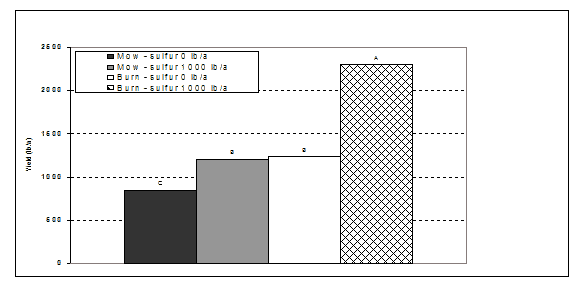
Fertilizer Use
Fertilizer has been shown to improve yields in conventional fields if the blueberry plants have less than 1.6% nitrogen or 1.3% phosphorus in their leaves. If fertilizer is applied when it is not needed it will stimulate weeds and not improve the blueberry yield. See Wild Blueberry Fact Sheet No. 222, Wild Blueberry Nutrition Series: Leaf and Soil Sampling Procedures, for information on how and when to sample.
Organic Herbicides
Allowed organic herbicides include top-kill herbicides such as vinegars and fatty acids and seedling inhibitor herbicides such as corn gluten3. These have limited use in wild blueberries; the top-kill herbicides must be applied to the weeds without hitting the blueberry plants as they will also defoliate the blueberry leaves. Because the weeds will generally recover faster than the blueberries, this will produce a net loss to the blueberry. Since the blueberry soil is not cultivated, the corn gluten will have little effect in inhibiting the weed seeds.
3Check with the Maine Board of Pesticides Control and the Maine Organic Farmers and Growers Association to determine what products are legal to use in Maine and are approved for organic production.
Fruit Quality
Concerns were raised by some organic growers in Maine that the addition of sulfur could impart an “off-flavor” to the blueberry fruit. Since no previous research had been done to investigate this possibility, we used fruit from an organic transition research site to test for the effect of the sulfur application on fruit quality. To do this we looked both at the chemical characteristics and mineral composition of the fruit and used a trained taste-test panel to evaluate the flavor attributes of the fruit obtained from the sulfur treated versus the non treated lowbush blueberry plots.
Elemental Analysis
Sulfur application did not affect berry acidity (pH), percent soluble solids or the berry color values as measured by the Hunter scale. However, soil pH in this study was significantly reduced, by 0.8 pH unit, with the sulfur application. Of the major nutrients, nitrogen and phosphorous were not affected by sulfur application, but calcium and magnesium were characterized by a small but significant decrease; this decrease was also seen in the soil analysis. Although potassium exhibited a small increase in the berries due to sulfur application, it was not increased in the soil by the sulfur treatment. Although the soil level of sulfur increased more than four-fold it did not increase in the fruit (Figure 12), so the concern of additional sulfur in the berry was unfounded. The minor nutrients aluminum, boron, copper, iron, and zinc were not affected by the sulfur treatment. However, manganese levels exhibited a significant increase from 130 ppm in the control to 230 ppm in the fruit from the sulfur treatment (Figure 13) but were not detected at higher levels in the soil treated with sulfur. The blueberry fruit manganese values are within the range of 119 ppm to 391 ppm with a mean of 250 ppm reported by a 1983 study by Bushway but significantly higher than the USDA values of 14.7 ppm for frozen fruit and 33.6 ppm for fresh blueberries. The lower pH environment resulted in the fruit accumulating nearly twice as much manganese as the untreated fruit. Since this element is within the range normally expected and is beneficial to human health, this is a positive added benefit to the use of sulfur to suppress weeds in wild blueberry fields.
Sensory Analysis
A preference or acceptability test was recommended because although the treatments may taste different, they may be equally liked by consumers or the sulfur-treated berries may be liked more than the berries without the treatment. Eighteen persons correctly identified the odd sample, indicating that a perceptible difference existed between the two types of berries. Comments made by panelists suggest that the sulfur treatment may have a beneficial effect. Panelists indicated that the berries not treated with sulfur had a ‘more tart/sharper taste’ suggesting that treatment with sulfur may have a beneficial effect on fruit flavor.
Sulfur Beneficial
The results of this study indicate that there should be no concern that the addition of sulfur added to wild blueberry fields for weed control will have a detrimental effect on fruit quality. The increase in the accumulation of manganese with the sulfur application is viewed a positive one as the manganese in blueberries aids in the maintenance of strong bones.
Future
The demand for organic foods is expected to increase in the future. Changes in production practices are also expected to occur as the cost of inputs change and as new organic practices are implemented. However, the obstacle for many in transiting to organic blueberry production is often in the area of business or marketing. Another fact sheet giving the cost and returns of organic production with the inputs used in this study and examples of successful organic enterprises will cover this subject.
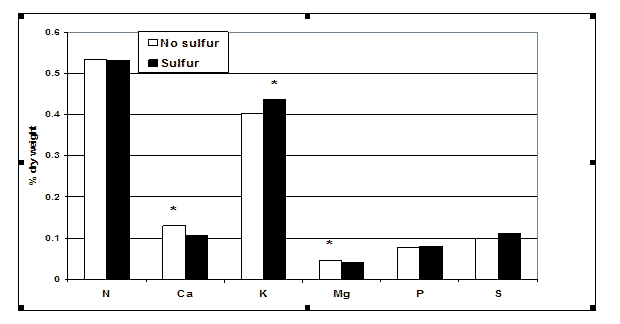
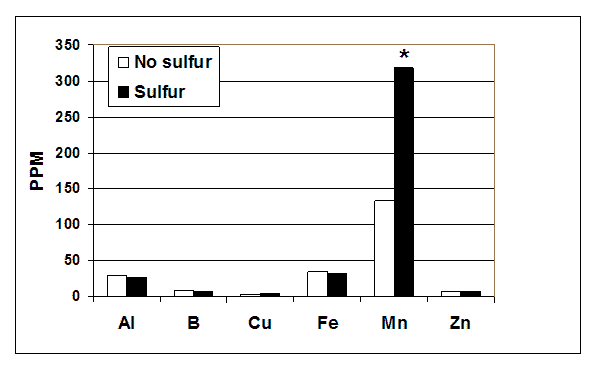
Acknowledgments
Funding for this report, and the research that led up to it, was made possible through a grant from the United States Department of Agriculture’s Organic Transitions Program for a project entitled, “Development and Implementation of Organic Pest Management Strategies for Lowbush Blueberries: A Multi-Year, Multi-Disciplinary Study” (Award Number 2003-51106-02119) and additional funding was provided by the Wild Blueberry Commission of Maine and the Maine Organic Farmers and Gardeners Association. The information provided in Figure 5 are data from Kristen McGovern’s MS thesis entitled “Organic Control of Monilinia blight of Lowbush Blueberry”. Thanks are extended to Kathleen Frost for helping with the initial draft, Phoebe Nylund and Jennifer D’Appollonio for their editorial assistance, and Eric Sideman and Peter Aldrich for their critiques.
Information in this publication is provided purely for educational purposes. No responsibility is assumed for any problems associated with the use of products or services mentioned. No endorsement of products or companies is intended, nor is criticism of unnamed products or companies implied.
© 2008
Call 800.287.0274 (in Maine), or 207.581.3188, for information on publications and program offerings from University of Maine Cooperative Extension, or visit extension.umaine.edu.
The University of Maine is an EEO/AA employer, and does not discriminate on the grounds of race, color, religion, sex, sexual orientation, transgender status, gender expression, national origin, citizenship status, age, disability, genetic information or veteran’s status in employment, education, and all other programs and activities. The following person has been designated to handle inquiries regarding non-discrimination policies: Director of Equal Opportunity, 101 Boudreau Hall, University of Maine, Orono, ME 04469-5754, 207.581.1226, TTY 711 (Maine Relay System).

